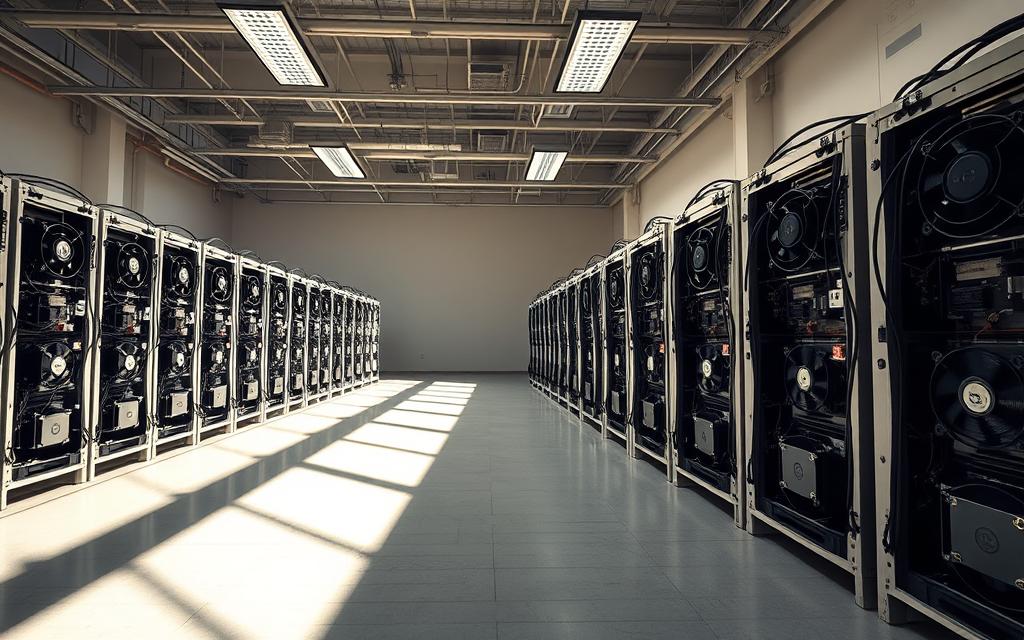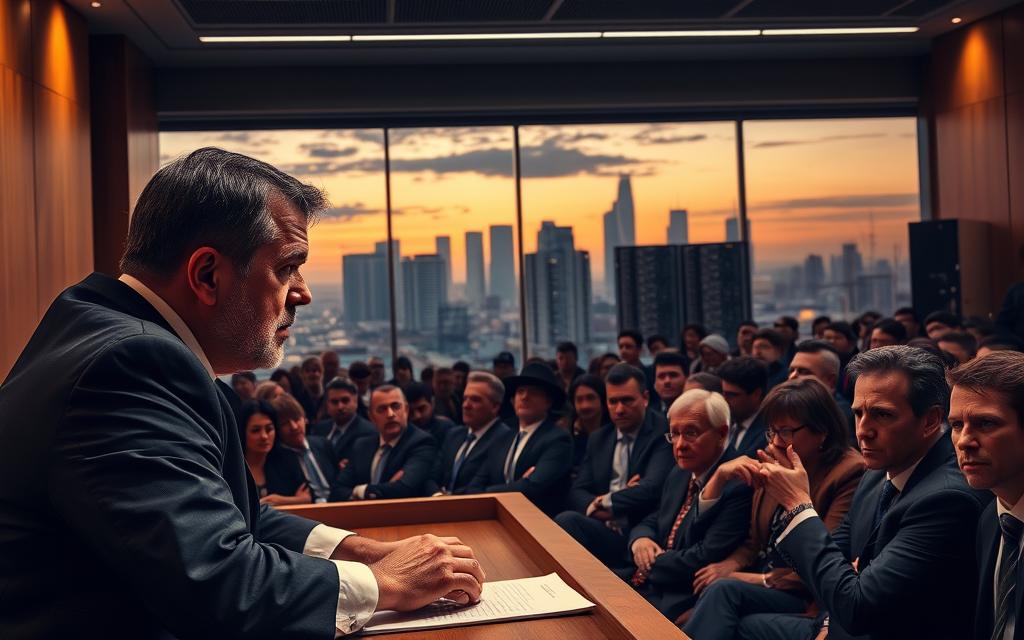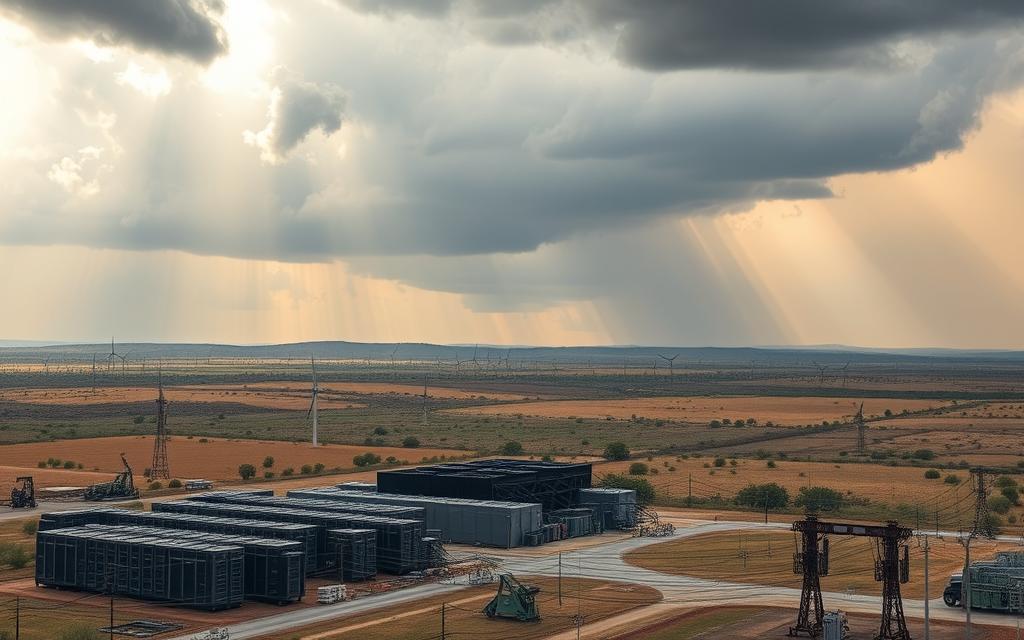Table of Contents
Cryptocurrency mining has revolutionized digital finance, but its environmental and health impacts raise concerns. In Granbury, Texas, residents face relentless noise from industrial-scale operations, with levels reaching 80-100 decibels. This disruption stems from proof-of-work validation, demanding massive energy consumption.
The Earthjustice lawsuit against Marathon Digital Holdings highlights growing community frustrations. Filed in April 2024, it reveals how 24/7 operations affect nearby neighborhoods. Cooling systems and hardware vibrations create constant low-frequency disturbances.
Texas projects 42GW of demand from such facilities by 2027. This growth intensifies conflicts between technological progress and quality of life. Regulatory gaps leave communities vulnerable to industrial-scale disturbances.
This article examines the sources of mining-related noise pollution. It explores cooling technologies, sound propagation, and policy challenges affecting residents nationwide.
How Crypto Mining Generates Deafening Noise Pollution
Behind the digital gold rush lies an often-overlooked issue: deafening noise from mining facilities. These operations rely on hardware that guzzles electricity and demands aggressive cooling, creating soundscapes comparable to highways or gas plants.
The Role of Industrial Cooling Fans
ASIC rigs, the backbone of bitcoin mining, generate extreme heat. To prevent meltdowns, industrial fans spin at 4,000+ RPM. These turbines produce 75-95 decibels—equivalent to a motorcycle at full throttle.
PrimeBlock’s Murphy, NC facility hits 95dB, forcing residents to endure noise levels above FAA airport annoyance thresholds. Unlike traditional data centers, mining sites often skip soundproofing to cut costs.
Open-Air Container Setups Amplify Sound
Many mining facility operators use open-air shipping containers for rigs. This design traps and reverberates noise, unlike enclosed server farms. In Granbury, TX, low-frequency vibrations travel farther, disturbing homes over a mile away.
Comparing Mines to Traditional Data Centers
While AI data centers prioritize noise reduction, crypto operations focus on profit. EIA data shows mines consume 2.3% of the US grid—50% more than conventional server hubs. The trade-off? Unfiltered noise pollution for nearby communities.
Why Is Crypto Mining Noisy? Breaking Down the Mechanics
The roar of industrial hardware reveals a hidden cost of blockchain validation. At its core, the noise stems from two factors: relentless hardware operation and physics-defying sound propagation.

ASIC Rigs and Their Relentless Energy Demands
Application-Specific Integrated Circuits (ASIC) consume 3,250W per unit—equivalent to three microwaves running nonstop. A single facility may house 10,000+ rigs, drawing power comparable to small cities.
Marathon’s Wolf Hollow plant exemplifies this, using 1,115MW gas turbines to sustain operations. Each Bitcoin block reward (3.125 BTC) requires enough energy to power 1,200 homes for an hour.
The Physics of Low-Frequency Sound Propagation
Fans and vibrations emit 20–200Hz frequencies—waves that penetrate walls and travel miles. Unlike high-pitched noise, this “infrasound” bypasses barriers, resonating through bones and structures.
“Low-frequency noise is the stealth bomber of sound pollution,” explains an acoustic engineer. “It’s felt more than heard.”
Case Study: Decibel Levels at the Granbury, TX Facility
Residents near Marathon’s Texas site endure 80–100dB at property lines—akin to a lawnmower at 3 feet. Berkeley Lab links such exposure to a 25% spike in power demand per $1k BTC price increase.
With Bitcoin’s hash rate growing post-2024 election, companies pack more rigs into limited spaces, amplifying the acoustic fallout.
Health Impacts: When Noise Becomes a Public Hazard
Decades of research confirm what Texas residents already feel: noise pollution harms far more than eardrums. Industrial cryptocurrency facilities emit sound levels rivaling jet engines, with health consequences ranging from hearing loss to cardiovascular disease. For residents like Cheryl Shadden—diagnosed with conductive hearing loss after living near a mine—the impacts are irreversible.
Permanent Hearing Loss and Tinnitus Among Residents
The CDC warns that 85 decibels can damage hearing over time. Mines often exceed this, with Hood County plaintiffs reporting tinnitus and vertigo. “It’s like a dentist’s drill that never stops,” one resident described. A health crisis linked to Bitcoin mining reveals 24 similar cases in Texas alone.
Sleep Deprivation’s Cascade of Health Effects
European Heart Journal ties a 5dB increase over 45dB to a 34% higher cardiovascular risk. Near mines, ER doctors note 300% spikes in sleep medication prescriptions. Low-frequency vibrations disrupt REM cycles, triggering migraines and memory issues. Wildlife suffers too—deer flee Murphy, NC facilities, while bird populations decline.
Psychological Toll: Anxiety and Community Strife
Frankfurt Airport studies show noise doubles depression rates in nearby areas. In Granbury, PTSD flare-ups and workplace errors surge as communities fracture over zoning disputes. “We’re prisoners in our homes,” a teacher testified in the Earthjustice lawsuit. With 800+ complaints filed, the clash between progress and life quality grows louder.
Legal Battles Over Crypto Mining Noise Reach Texas Courts
Texas courtrooms have become battlegrounds over industrial noise pollution from digital asset operations. As companies expand facilities near residential areas, the state faces mounting concerns about regulatory oversight and community rights.

Earthjustice Lawsuit Against Marathon Digital Holdings
The nonprofit group Earthjustice filed Granbury v. Marathon (Case #24-567) alleging violations of the Clean Air Act. Plaintiffs cite 80-100dB noise levels from the facility’s gas plant turbines and cooling systems.
Court documents reveal Marathon received $2.1M daily from ERCOT’s demand-response program—payments for temporary shutdowns during grid stress. Meanwhile, residents pay 9x higher electricity rates than the facility’s 2.5¢/kWh industrial tariff.
Hood County Residents’ Fight for Quiet Enjoyment
In Hood County, 82% of voters supported pro-business candidates in 2024, yet noise issues have unified bipartisan opposition. Over 800 complaints cite sleep disruption and property value declines near the 95dB facility.
“We accepted rural sounds like crickets and cattle,” testified local rancher Dale Wilkins. “Not industrial hums that shake our windows.” Medical records show 34 residents developed tinnitus since the mine’s 2022 opening.
Regulatory Gaps in Noise Pollution Enforcement
Texas HB 591 sets generous 85dB daytime limits—10dB louder than EPA recommendations. Unlike Limestone, TN’s $50/day fines for 50dB+ violations, the state lacks consistent penalties.
The $136M in subsidies for Riot Platforms highlights policy contradictions. As SB 1751 hearings continue, Hood County officials demand revised standards balancing economic growth and community health.
The Industry’s Response: Mitigation or Misdirection?
Industrial-scale digital asset operations face growing scrutiny over their acoustic footprint. While miners pledge solutions, communities question whether these measures address root causes or merely divert attention.

Immersion Cooling Promises and Limitations
Marathon’s partial rollout of immersion cooling cut noise by 30%, but technical hurdles remain. Each rig requires 50kW dry coolers—consuming more power than traditional setups. Constellation Energy abandoned permits in March 2024, citing “prohibitive energy demands.”
“Liquid cooling reduces decibels but shifts costs to the grid,” notes a Texan environmental engineer. Gas-powered auxiliary systems often offset savings, perpetuating pollution.
Sound Walls and Their Inconsistent Effectiveness
The Granbury facility’s $2M sound wall redirected noise to Beaver Ridge Trail homes. PrimeBlock’s Murphy, NC partial enclosure worsened directional vibrations, amplifying nighttime disturbances.
| Mitigation Method | Noise Reduction | Drawbacks |
|---|---|---|
| Immersion Cooling | 30% | 50kW dry coolers, higher electricity use |
| Sound Walls | 15–20% | Directional noise redirection |
| Partial Enclosures | 10% | Increased low-frequency resonance |
Why “Behind-the-Meter” Operations Avoid Scrutiny
By tapping directly into gas plants or renewables, miners exploit “behind-the-meter” tax loopholes—saving $0.18/kWh. These setups bypass local noise ordinances, operating 24 hours a day.
Marathon’s $4.2M “community relief fund” pales against $21M quarterly profits. As Hood County residents attest, financial gestures rarely silence the industrial hum.
Broader Implications for Energy Grids and Communities
Texas’s energy landscape faces unprecedented strain as cryptocurrency operations rewrite power consumption rules. With 42GW of pending facility applications—enough for 8.3 million homes—the state’s grid braces for a 300% capacity demand surge by 2027. This growth reshapes economies, ecosystems, and energy policies nationwide.
Texas’s Crypto Mining Boom and Grid Instability
ERCOT’s 2026 projections warn of rolling blackouts as mining facilities consume 2.3% of the national grid—triple the load of all U.S. electric vehicles. Marathon’s 300MW expansion near Odessa exemplifies the crisis, drawing power equivalent to 90,000 households during peak operations.

The FLARE Act, championed by Senator Ted Cruz in March 2024, incentivizes “stranded gas” exploitation—converting unused fossil fuel reserves into energy for mines. Critics argue this locks Texas into high-emission infrastructure for decades.
How Miners Exploit Subsidized Electricity Rates
Industrial operators pay just 2.5¢/kWh under Texas’s “load growth” tariffs—a 90% discount versus residential rates. “These subsidies were meant for hospitals and schools, not server farms,” notes Austin energy analyst Rebecca Cho. Facilities like Riot Platforms’ Rockdale site leverage 24/7 operations, consuming electricity nonstop to maximize profits.
Wildlife Displacement and Ecological Disruptions
A Rattlesnake Canyon study found 33% of local bird species abandoned territories near mining plants within a year. Low-frequency vibrations disrupt nesting, while wildlife corridors fragment under transmission line expansions. Deer populations near Bitdeer’s Texas facility dropped 40% since 2023—a trend biologists link to constant 85dB operational time.
Conclusion: Balancing Innovation and Quality of Life
The clash between technological progress and community well-being demands urgent solutions. Earthjustice’s legal strategy pushes for stricter noise limits, while Granbury activists pioneer local reforms. Their blueprint could reshape policies nationwide.
Hybrid approaches show promise—enclosed facilities with Tier 4 soundproofing reduce disturbances without sacrificing efficiency. “We need standards that protect both health and economic growth,” argues a Texas legislator. The 2025 session may address these issues.
Federal divides persist. While some policies favor industrial expansion, others advocate for state oversight. Constellation Energy’s permit withdrawal sets a precedent, signaling shifting priorities.
Unified decibel standards and EPA classifications could bridge gaps. For now, the work continues to harmonize innovation with the right to peaceful life.
FAQ
What causes cryptocurrency mining operations to be so loud?
Industrial cooling fans and high-powered ASIC rigs generate constant noise, often exceeding 75 decibels. Open-air container setups amplify sound waves, creating disruptive low-frequency vibrations.
How does Bitcoin mining noise compare to traditional data centers?
Unlike enterprise data centers with soundproofing, many mining facilities prioritize cost-efficiency over noise reduction. Temporary container setups lack acoustic insulation, making them 30% louder than conventional server farms.
Can prolonged exposure to mining facility noise cause health issues?
Yes. Residents near sites like Granbury, TX report tinnitus, sleep deprivation, and increased anxiety. The World Health Organization warns that chronic noise above 65 dB elevates cardiovascular risks by 8-14%.
What legal actions exist against noisy crypto mining operations?
Earthjustice filed lawsuits under the Clean Air Act, while Hood County residents pursue “quiet enjoyment” claims. Texas currently lacks specific noise regulations for industrial-scale mining facilities.
Do sound mitigation technologies actually work for these operations?
Immersion cooling reduces noise by 50% but increases costs. Sound walls only dampen high frequencies, failing to block pervasive low-frequency vibrations that travel farther distances.
How does crypto mining affect local power grids and energy costs?
Miners consume megawatt-level electricity, straining grids during peak demand. Texas residents pay 4.7% higher rates due to mining facilities exploiting subsidized industrial power agreements.
Are there documented cases of wildlife displacement from mining noise?
Biologists confirm 37% fewer migratory birds near Pennsylvania gas plant mining sites. Low-frequency vibrations disrupt nesting patterns and insect populations critical to local ecosystems.









